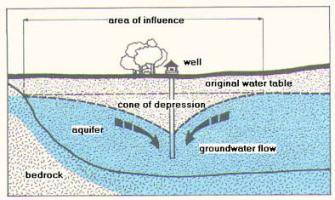Competency Area 6: Watershed hydrology AEM
PO 63. Understand the concepts of pumping and drawdown in wells, the cone of depression, and well capture zones.
When wells are pumped, the water level in the casing is lowered (drawn down) relative to the water level in the aquifer. This drawdown causes stored water in the aquifer to flow towards the well. The cone of depression refers to this drawdown, since the water level surface in the aquifer material exhibits a conical shape with increasing distance in all directions away from the well. The bottom of the cone is the drawdown water level in the well. The size of the cone of depression, or the distance away the water level is affected by a pumping well depends on the pumping rate, the specific yield and conductivity of the aquifer material, and the length of time the well is pumped. High pumping rates for long periods of time will lower water levels a long distance away. In unconfined aquifers, the water level is typically affected less than 100 feet away, but can extend for several hundred feet. However, in confined aquifers, the water level can be affected for several hundred to several thousand feet away.
The capture zone of a well refers to the area on the surface under which water drains towards a pumping well. Essentially this area extends up-gradient from the well to the boundary of the groundwater divide (where the groundwater would slope to another direction). The importance of defining the extent of the capture zone is that activities on the land surface that overlie the capture zone may eventually pollute the well. Pollutants that readily leach, and which are transported to the aquifer, will affect the well water quality. Shallow unconfined aquifers are particularly vulnerable to contamination because there is no restricting soil layer above these aquifers to divert leached pollutants.

Image from "What is Groundwater?" by Dr. Lyle S. Raymond Cornell University Water Resources Institute image source: http://hdl.handle.net/1813/3408
Quick Links
- Competency Area 1: Basic soil properties
- Competency Area 2: Soil hydrology AEM
- Competency Area 3: Drainage and irrigation AEM
- Competency Area 4: Soil health and compaction
- Competency Area 5: Soil conservation AEM
- Competency Area 6: Watershed hydrology AEM
- Competency Area 7: Non-point source pollution AEM
- Competency Area 8: Concentrated source pollution AEM
- Competency Area 9: Conservation planning AEM
